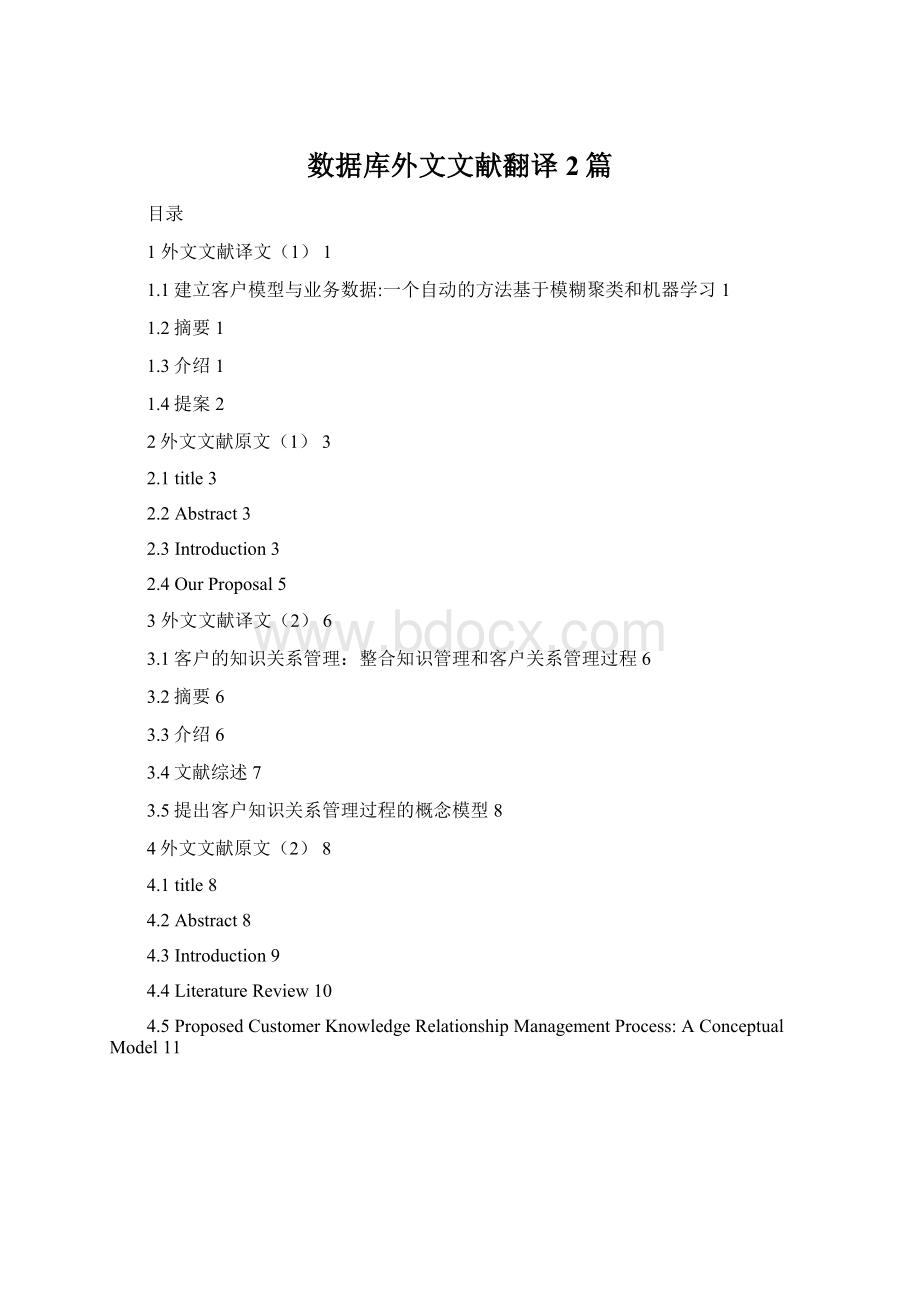数据库外文文献翻译2篇.docx
《数据库外文文献翻译2篇.docx》由会员分享,可在线阅读,更多相关《数据库外文文献翻译2篇.docx(13页珍藏版)》请在冰豆网上搜索。

数据库外文文献翻译2篇
目录
1外文文献译文
(1)1
1.1建立客户模型与业务数据:
一个自动的方法基于模糊聚类和机器学习1
1.2摘要1
1.3介绍1
1.4提案2
2外文文献原文
(1)3
2.1title3
2.2Abstract3
2.3Introduction3
2.4OurProposal5
3外文文献译文
(2)6
3.1客户的知识关系管理:
整合知识管理和客户关系管理过程6
3.2摘要6
3.3介绍6
3.4文献综述7
3.5提出客户知识关系管理过程的概念模型8
4外文文献原文
(2)8
4.1title8
4.2Abstract8
4.3Introduction9
4.4LiteratureReview10
4.5ProposedCustomerKnowledgeRelationshipManagementProcess:
AConceptualModel11
1外文文献译文
(1)
1.1建立客户模型与业务数据:
一个自动的方法基于模糊聚类和机器学习
1.2摘要
数据挖掘(DM)是一门新兴学科,旨在从数据中提取知识使用几种技术。
DM证明是有用的业务数据的描述客户和他们的交易以兆兆字节。
在本文中,我们提出的方法建立客户模型(也说在文献资料)与业务数据。
我们的方法是三步。
在第一步中,我们使用模糊聚类分类的客户,即确定客户群。
一个关键特性是,很多团体(或集群)自动计算从数据使用划分熵作为真实性的标准。
在第二步中,我们进行降维旨在保持为每组只有客户的信息最丰富的属性。
为此,我们定义了信息损失量化信息程度的一个属性。
因此,作为结果,第二步,我们获得的消费者群每个描述由一种独特的属性集。
在第三个和最后一步,我们使用摘要神经网络中获取有用的知识从这些组织。
真实世界的数据集上的实验结果揭示了我们的方法的良好性能,应该模拟未来的研究。
关键字:
数据挖掘、客户利润、客户关系、模糊聚类、降维、倒传递类神经网路、信息原理
1.3介绍
如果可以探测和预测客户的行为改变,营销管理能够和客户发展长期和愉快的关系。
在过去,研究人员通常使用应用统计调查研究客户的行为。
最近,数据挖掘技术已经采用,这些技术的目标通过搜索数据库以获取隐式的,未知,和潜在有用信息,包括知识规则、约束和规律。
数据挖掘,是数据库的中知识发现关键的一步,包括特定算法的模式提取的应用,像网络、市场、金融和银行业务这些领域已经有多方面成功的应用。
目前,企业面临的挑战是一个不断发展的市场,客户的需求在不断地变化。
因此,代替对待所有客户一样,企业可以只选择那些符合特定的盈利条件的客户,标准基于他们个人的需求或消费行为。
这样,所发现的信息可以为市场做更精准的决策。
因此,可以定义对客户概括的数据挖掘,是简单地作为的允许建立描述一组特定的习惯、态度和行为客户档案的技术。
数据挖掘技术在客户分析中面临一些困难,大量的数据可用来创建用户模型,数据是否适当,数据噪音问题和和捕获人类不确定性行为的必要性。
数据挖掘和机器学习技术能够处理大量的数据和不确定性。
这些特征使这些技术实现客户模型的自动生成,提高决策效率。
一些文献提出人工智能技术可以解决这个问题。
事实上,许多工业应用程序为了发展客户分析已经使用贝叶斯网络、决策树、支持向量机、人工神经网络和关联规则技术。
以后,我们将列出一些对于客户分析的研究活动,向新手读者介绍一些该领域的背景知识。
如果想对现有方法深入学习,感兴趣的读者参考相关的专业文献。
第十七文献中提出一个集成的数据挖掘模型和行为得分模型管理银行现有的信用卡客户。
区分基于还款行为时效性、频率、货币行为和得分的预测因子的客户群,使用自组织映射方法。
同样将银行的客户分为三种主要盈利的客户群,使用先验的关联规则挖掘不同客户群的功能属性。
其他方法也在零售市场得到应用,因为在动态的零售市场观察客户行为的变化可以帮助管理者建立有效的宣传活动。
第五文献中的模型,合并了客户行为变量,人口统计学变量和事务数据库统计客户的行为变化。
为了挖掘变化模式,相似性和不可预测性两种扩展特征用来分析不同时期模式的相似度。
关联规则挖掘首次发现客户行为模式。
自从发现了关联规则,通过比较两组不同时期的数据的关联规则确定客户行为的变化。
基于先前的学习,客户行为改变包括出现模式、增加模式、流失模式和不确定模式。
第四十文献中另一个值得注意的案例,现在这个模式使用到其他的服务,目前提供给移动电信用户。
使用要素分析,聚类和定量关联规则这些方法发现细分客户群采用的服务模式,从这些分析中,确定了三种类别的用户。
第一类用户由新一代利用额外服务收费的用户组成,组要为了休闲和娱乐。
年轻的一代比年长的一代更频繁地使用手机,他们趋向展示更高的各种不同的附加服务使用模式。
第二类用户使用实际的附加服务,低价或免费的如“数据服务”和“通话服务”通过“来电显示请求服务”。
最后一类用户没有明显的特征。
这份研究使用关联规则发现在每个用户群,为不同用户组的移动服务市场提供战略指导。
第29文献中模型挖掘客户行为以帮助经理们为公司提出更好的促销活动和其他相关决策。
关联规则的关系数据库设计实现了挖掘系统帮助电子目录设计和促销策略设计。
关联规则在相关的数据库的应用挖掘消费行为,以便生成零售业购物中心的交叉销售的电子目录设计和营销方案。
在本文中,我们提出一种方法从业务数据中开发自动客户分析(模型)。
它涉及到三个步骤,在第一步中,用模糊聚类方法分类的客户。
模糊聚类算法关键的一步是决定划分聚类的组数,自动从数据使用分区熵作为一个有效措施。
在第二步中,维(或属性数量)对于每个集群(或一组客户)减少选择只有信息最丰富的属性。
选择是基于属性信息的损失;量计算运用信息熵的属性。
因此,第二步的结果,我们获取几组的消费者群,他们每个人都被一个不同的组,每组的属性被认定为信息最丰富的。
在第三步,最后一个步骤中,每个聚类减少训练,从反馈网络中提取有用的知识。
因此,连接客户分析(或模型)我们获取一组反馈网络编码和分类未知潜在的客户。
下文组织如下,第二章中我们详细描述我们的模型。
第三章中将进行实验分析了,而最后一章是论文总结和对未来研究的发展方向。
1.4提案
我们的方法是三步,总结了图1。
首先,我们使用模糊聚类算法细分客户群。
该方法的一个重要特性是使用划分熵作为一个有效性度量自动计算聚类的数量。
通过这种方式,最优的聚类数量是能够产生最低划分熵。
第一步的结果,从消费习惯,,收入等相似性方面细分获取几组描述客户类别。
第二步,继续降维保持聚类的相关属性。
事实上,聚类中的属性不是所有都是相关的,有一些属性应该删除。
重复步骤,利用决策树方法来决定一个属性是否重要,关于给定一组客户中使用定义信息丢失的阈值。
第三,每个聚类被导入倒传递网络提取有用的信息。
整个算法的结果,获取客户细分结果。
这样,新一轮分类后以前未知的客户就变成非常容易的任务。
接下来的部分,将详细描述方法中每一步。
2.2第二步,属性的选择
自然,在相同的集群(同一群顾客)中,并不是所有的初始属性是有效,其中有些应该被丢弃。
衡量一个属性传达的信息,在一个给定的聚类的值,使用基于该属性值的频率的熵。
我们将使用图2中相同的聚类方法计算这个频率,但是只适用于一个数据集组成的属性值。
在给定一组客户中一个属性可能值的数量无法准确计算,特别是可能会非常接近的数值属性值,但不是完全相同的。
给定客户群的属性运用图2的聚类方法,获取一组嵌入属性值非常类似的聚类;因此相应的集群多次相似的值被视为一个单一值。
在进一步深入学习之前,现在我们需要以下的注释。
2外文文献原文
(1)
2.1title
Buildingcustomermodelsfrombusinessdata:
anautomaticapproachbasedonfuzzyclusteringmachinglearning
2.2Abstract
Datamining(DM)isanewemergingdisciplinethataimstoextractknowledgefromdatausingseveraltechniques.DMturnedouttobeusefulinbusinesswherethedatadescribingthecustomersandtheirtransactionsisintheorderofterabytes.Inthispaper,weproposeanapproachforbuildingcustomermodels(saidalsoprofilesintheliterature)frombusinessdata.Ourapproachisthree-step.Inthefirststep,weusefuzzyclusteringtocategorizecustomers,i.e.,determinegroupsofcustomers.Akeyfeatureisthatthenumberofgroups(orclusters)iscomputedautomaticallyfromdatausingthepartitionentropyasavaliditycriteria.Inthesecondstep,weproceedtoadimensionalityreductionwhichaimsatkeepingforeachgroupofcustomersonlythemostinformativeattributes.Forthis,wedefinetheinformationlosstoquantifytheinformationdegreeofanattribute.Hence,andasaresulttothissecondstep,weobtaingroupsofcustomerseachdescribedbyadistinctsetofattributes.Inthethirdandfinalstep,weusebackpropagationneuralnetworkstoextractusefulknowledgefromthesegroups.Experimentalresultsonreal-worlddatasetsrevealagoodperformanceofourapproachandshouldsimulatefutureresearch.
Keywords:
Datamining;customerprofiling;customerrelationshipsmanagement(CRM);fuzzyclustering;dimensionalityreduction;backpropagationnetworks;informationtheory.
2.3Introduction
Marketingmanagerscandeveloplong-termandpleasantrelationshipswithcustomersiftheycandetectandpredictchangesintheirbehavior.Inthepast,researchersgenerallyusedtoapplystatisticalsurveystostudycustomerbehavior.Recently,dataminingtechniqueshavebeenadopted.Thesetechniquesaimtosearchthroughadatabasetoobtainimplicit,previouslyunknown,andpotentiallyusefulinformationincludingknowledgerules,constraintsandregularities.Datamining,akeystepinKnowledgeDiscoveryinDatabases(KDD),involvestheapplicationofspecificalgorithmsforpatternextraction.Varioussuccessfulapplicationshavebeenreportedinareassuchastheweb,marketing,financeandbanking.Currently,businessesfacethechallengeofaconstantlyevolvingmarketwherecustomerneedsarechangingallthetime.Hence,insteadoftargetingallcustomersequally,enterprisescanselectonlythosecustomerswhomeetcertainprofitabilitycriteriabasedontheirindividualneedsorpurchasingbehaviors.
Asaresult,thediscoveredinformationcanbeascertainedtosupportbetterdecisionmakinginmarketing.Consequently,onecandefinedataminingincustomerprofilingsimplyasbeingthetechnologythatallowsbuildingcustomerprofileseachdescribingthespecifichabits,attitudesandbehaviorofagroupofcustomers.Someofthedifficultiesfacedbydataminingtechniquesforcustomerprofilingaretheamountofdataavailabletocreateusermodels,theadequacyofthedata,thenoisewithinthatdata,andthenecessityofcapturingtheimprecisenatureofhumanbehavior.Dataminingandmachinelearningtechniqueshavetheabilitytohandlelargeamountsofdataandtoprocessuncertainty.Thesecharacteristicsmakethesetechniquessuitablefortheautomaticgenerationofcustomermodelsthatsimulatehumandecision-making.SeveralArtificialIntelligencetechniqueshavebeenproposedintheliteraturetoaddressthisproblem.Infact,modelsusingBayesiannetworks,decisiontrees,supportvectormachines,artificialneuralnetworks,andassociationruleshavebeenusedinmanyindustrialapplicationsinordertodevelopcustomerprofiles.Hereafter,wewilloutlinesomeoftheresearchactivitiesforcustomerprofilingtogivethenovicereadersomebackgroundinthefield.Foranexhaustivereviewofexistingapproaches,werefertheinterestedreadertothespecializedliterature.
rtheinterestedreadertotheThemodelinRef.17proposesanintegrateddataminingandbehavioralscoringmodeltomanageexistingcreditcardcustomersinabank.Aself-organizingmapwasusedtoidentifygroupsofcustomersbasedonrepaymentbehaviorandrecency,frequency,monetarybehavioralandscoringpredictors.Italsoclassifiedbankcustomersintothreemajorprofitablegroupsofcustomers.Theresultinggroupsofcustomerswerethenprofiledbycustomer’sfeatureattributesdeterminedusinganaprioriassociationruleinducer.
Otherworksarealsodevelopedinretailmarketingbecauseunderstandingchangesincustomerbehaviorinthedynamicretailmarketcanhelpmanagerstoestablisheffectivepromotioncampaigns.ThemodelinRef.5integratescustomerbehavioralvariables,demographicvariables,andtransactiondatabasetoestablishamethodofminingchangesincustomerbehavior.Forminingchangepatterns,twoextendedmeasuresofsimilarityandunexpectednessaredesignedtoanalyzethedegreeofresemblancebetweenpatternsatdifferenttimeperiods.Customerbehaviorpatternsarefirstidentifiedusingassociationrulemining.Oncetheassociationrulesarediscovered,thechangesincustomerbehaviorareidentifiedbycomparingtwosetsofassociationrulesgeneratedfromtwodatasetsatdifferentperiods.Basedonpreviousstudies,changesincustomerbehaviorincludeemergingpatterns,addedpatterns,perishedpatterns,andunexpectedpatterns.
AnotherworkworthyofnoticeisthatproposedinRef.40whichpresentsthepatternsofuseforadditionalservicesthatarecurrentlyprovidedtomobiletelecommunicationsubscribers.Factoranalysis,clusteringandquantitativeassociationrulesareusedtofindtheserviceadoptionpatternsofsegmentedgroups.Fromtheanalysis,threecategoriesofusersareidentified.Thefirstgroupconsistsofanewgenerationofcustomerswhoutilizechargeableadditionalservicesusingthe“directbutton”,forleisureandentertainment.Theyoungergenerationusetheirmobilephonesmorefrequentlythantheoldergeneration,andtendtodisplayhigherusagepatternsforavarietyofadditionalservices.Thesecondgrouputilizespracticaladditionalservicesthatarelow-pricedorfreesuchas“dataservice”and“phone-to-phoneservice”via“CallerIDrequestservice”.Thecustomersinthefinalgrouparepeoplewhohavenogeneralusagecharacteristics.Thisstudyutilizestheassociationrulesfoundineachclustertoprovidestrategicguidancetoenhancethemobileservicemarketofthecorrespondinggroup.
ThemodelinRef.29minescustomerbehaviortoassistmanagersindevelopingbetterpromotionandotherrelevantpoliciesforafirm.Theassociationrulesofthere